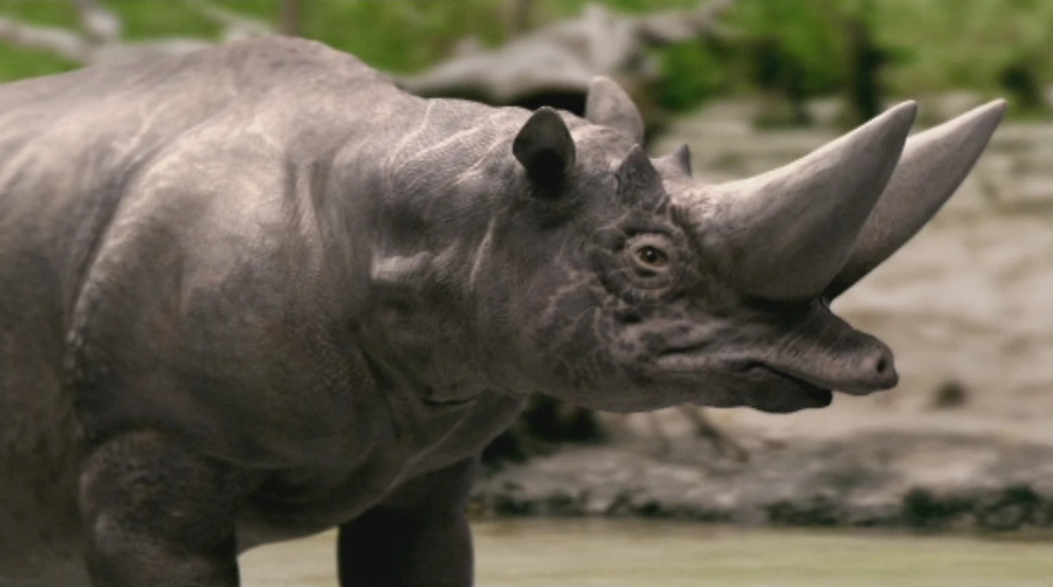
Geographical distribution during the Eocene epoch
The intriguing Arsinoitherium is an extinct animal that inhabited the ancient African landscapes in the late Eocene period. This herbivorous mammal had a distinct look that distinguished it from all the other animals of its day. It was around the size of a contemporary rhinoceros. Its two massive, forward-facing horns, wrapped in a hard keratin sheath and composed of bone, were what set it apart from other animals. Arsinoitherium had a powerful presence in its surroundings because of its enormous horns, which were probably used for defence and territorial conflicts.
Unique features, such as the large horn-like structures on its head
Arsinoitherium was able to hold its weight and travel with reasonable ease due to its strong body and short, stocky legs, in addition to its spectacular horns. It possessed a tiny head with strong jaws that were furnished with sharp teeth, as well as a long, flexible neck. Arsinoitherium’s distinct morphological characteristics imply that it was a well-adapted organism to its surroundings, maybe using its horns to ward off predators and its powerful jaws to feed on plants.
study of Arsinoitherium contributes to our understanding of ancient ecosystems
Arsinoitherium’s fossil record offers important insights into the development of mammals. It is thought to have been among the first creatures in the order Embrithopoda, which was made up of herbivorous mammals before they became extinct. The variety of mammalian life during the Eocene era and the ancient ecosystems of the continent have been illuminated by the finding of Arsinoitherium fossils in Egypt and other regions of Africa. Scientists have been able to put together a fuller picture of the evolutionary processes that produced the mammalian fauna of Africa millions of years ago by examining the morphology and behaviour of Arsinoitherium.
Study of prehistoric animals: significant fossil findings in different regions
The extinct animal Arsinoitherium existed in the Eocene period around 36 million years ago. Arsinoitherium inhabited the Earth millions of years ago; its influence on palaeontology and our comprehension of the planet’s evolutionary past endures now. Its unique features and adaptations make it a fascinating organism to study, and its legacy endures in the form of well-preserved fossils and museum exhibits. It may weigh up to 3,000 kg, making it one of the biggest land animals of its era. The following are some amazing facts about Arsinoitherium:
1. When and where its fossils were first discovered:
British palaeontologist Richard Markham found the first Arsinoitherium bones in the late 19th century in Egypt’s Fayum Depression. They were found around an old waterhole, indicating that this herbivorous species was a water-loving creature.

2. Taxonomic classification of Arsinoitherium:
Named after Queen Arsinoe II, who controlled the area at the time of its discovery, “Arsinoitherium” is derived from the Greek terms “Arsinoe” (meaning “woman from marshes”) and “therion” (meaning “beast”). It was identified as a member of the hornless browsing mammals, or Embrithopoda, an extinct order.
3. Physical Characteristics: Size and Appearance:
Arsinoitherium resembled a contemporary rhinoceros in size, standing around 2.5 metres (8.2 feet) tall at the shoulder and 4 metres (13 feet) long. It had four strong legs, a long, thick tail, and a huge, massive torso. Its three pairs of huge bony protuberances on its cranium, called pseudo-horns since they were hollow within, were what made it stand out the most.
4. Ferocious tooth evidence supporting its feeding behaviour:
Arsinoitherium has vicious teeth that it utilises to protect itself from predators, even though it has a herbivorous diet. On its lower jaw were two huge pairs of horns that resembled bone, which it used to break fruits, seeds, and leaves. Its molars, with their high-ridged enamel, were ideal for crushing tough plants.
5. Adaptations for obtaining and consuming food:
Arsinoitherium has good environmental adaptations. Its strong legs enabled it to walk on the muddy lake bottoms of the Faiyum Oasis, and its solid bones allowed it to swim in deep water. It also has a remarkably flexible nose, which it uses to pick up leaves and branches and eat them.
6. Social behaviour and structure:
Arsinoitherium is thought to have travelled in groups in search of food and water. Multiple individuals’ buried remains discovered together indicate that they were gregarious creatures, and their size could have protected them from predators.
7. End of its reign:
Although the exact date of Arsinoitherium’s extinction is unknown, it is thought to have happened around 33.9 million years ago, at the end of the Eocene period. This could have happened as a result of environmental changes, such as fewer water supplies or competition from other herbivores for food.
8. Ancestor to modern-day mammals:
Due to Arsinoitherium’s distinctive characteristics, scientists now think that it is a distant relative of mammals like hippopotamuses, elephants, and rhinoceroses. It is believed to have gotten its semi-aquatic characteristics and broad tail from a single progenitor.
9. Museum depictions of Arsinoitherium in art or literature:
Detailed fossil reconstructions that are on display in museums all around the globe have managed to bring Arsinoitherium back to life despite its demise. The Natural History Museum of London has the largest collection of fossilised Arsinoitherium, with its skull and other anatomical features on exhibit.
10. Significance in evolutionary research:
Arsinoitherium is regarded as a crucial species in evolutionary research, offering insightful information on the development of big terrestrial animals. Scholars examining the variety and development of extinct mammal species find it to be an intriguing topic due to its distinct characteristics and adaptations.



